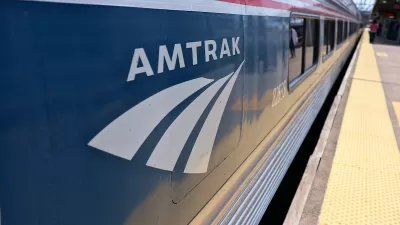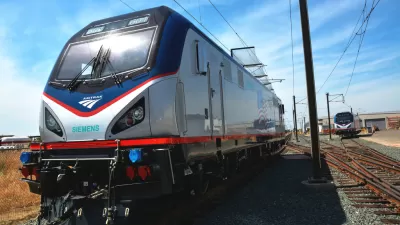Two weeks after Congress passed HR 2095, Bush signed this bill to double Amtrak funding and mandate safety technology to prevent Metrolink-like crashes. It may be a precursor to greatly expanded transit spending in the next administration.
"President Bush today signed into law a bill to provide billions of dollars to boost passenger rail safety and strengthen Amtrak, including upgrades to the Northeast Corridor.
The legislation, pushed by New Jersey Democratic Sen. Frank Lautenberg, would allocate $1.6 billion for rail safety, and renew and expand the Federal Railroad Administration.
Additionally, the bill contains a provision pushed by Republicans to open up the Northeast Corridor to private competition. Specifically, the measure would allow the transportation secretary to invite bids from private companies to build new high-speed rail tracks alongside existing ones in the Northeast and other well-traveled corridors."
from wsj:
"The legislation provides roughly $13 billion for Amtrak and passenger-rail funding over five years, nearly double current spending levels.
The shift to rail and away from cars -- Americans have been driving less for nearly a year now -- will also affect next year's debate on a transportation-spending bill that could cost as much as $500 billion. Currently, the federal government spends more than $40 billion annually on highways, roughly $10 billion on mass transit and about $1.4 billion on Amtrak.
Going forward, debate will also focus on whether to allocate federal dollars differently. Several Democratic leaders who will play key roles in the coming transportation debate say concerns over congestion, pollution and oil consumption should lead to greater spending on passenger-rail service."
Thanks to MTC-ABAG Library
FULL STORY: Bush signs rail bill

Alabama: Trump Terminates Settlements for Black Communities Harmed By Raw Sewage
Trump deemed the landmark civil rights agreement “illegal DEI and environmental justice policy.”

Planetizen Federal Action Tracker
A weekly monitor of how Trump’s orders and actions are impacting planners and planning in America.

The 120 Year Old Tiny Home Villages That Sheltered San Francisco’s Earthquake Refugees
More than a century ago, San Francisco mobilized to house thousands of residents displaced by the 1906 earthquake. Could their strategy offer a model for the present?

Ken Jennings Launches Transit Web Series
The Jeopardy champ wants you to ride public transit.

BLM To Rescind Public Lands Rule
The change will downgrade conservation, once again putting federal land at risk for mining and other extractive uses.

Indy Neighborhood Group Builds Temporary Multi-Use Path
Community members, aided in part by funding from the city, repurposed a vehicle lane to create a protected bike and pedestrian path for the summer season.
Urban Design for Planners 1: Software Tools
This six-course series explores essential urban design concepts using open source software and equips planners with the tools they need to participate fully in the urban design process.
Planning for Universal Design
Learn the tools for implementing Universal Design in planning regulations.
Clanton & Associates, Inc.
Jessamine County Fiscal Court
Institute for Housing and Urban Development Studies (IHS)
City of Grandview
Harvard GSD Executive Education
Toledo-Lucas County Plan Commissions
Salt Lake City
NYU Wagner Graduate School of Public Service




























